Infill in Edmonton: building a home with c-cans
How it all started
When first contacted to do this job, moving c-cans for Copperblock, for infill in Edmonton Alberta, the c-cans were stuck out on an acreage, near Spruce Grove, with their trucker unavailable, and the site was an infill in an old neighbourhood. I went to both sites. The usual method of a large crane from the street was unavailable. There were bike lanes, and high trees, and one quite annoyed neighbour that I visited several times just to keep the peace.
The cans were approx. 9000 lbs, the road and trees and bike lanes, and the likelihood of having to lift over neighbouring houses meant we had to access from the back.
As you might know, an older alley is normally 18 ft wide. When we went to the site, we realized why Copperblock had called us. We are a specialty and lifting solutions provider. This was a narrow lane, with a forest of wires right down the edge of the property line. We had to get the c-cans under that wire, and more importantly, one of our big cranes inside, waiting to grab it. The c-cans were 40 ft long and 9 ft high; our trailer package, would be 75 ft, and the crane 40 ft by itself.
I took a bunch of measurements and lots of pictures, then took one of our larger knuckle booms with a step-deck to Spruce Grove. They were in trouble with the timelines; we wanted to help, so we dispatched our truck. We were excited for an infill in Edmonton Alberta opportunity.
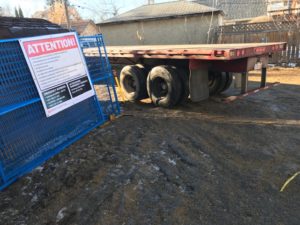
Site Condition
The site was an old residence that had an abandoned look to it; house in the front, windy tree and bush restricted access; then another trail through abandoned machinery, old cars, more bush and piles of what look like scrap. I walked in, found the c-cans in the back, and knew it was so tight an area I could probably never turn around.
So, I backed the trailer off the icy road into the narrow access, and on the first corner, a 90-degree swing across the front of the house to get down the side of the property. I dropped a wheel into a pile of old branches, leaves and dirt that had been pushed off the road some years before. Then I needed to swing the tractor through this to make the corner. I dug my way out of the composting pile and worked the wheel out with a bit of big truck muscle. It can be hard to infill in Edmonton Alberta.
The rest was a driving test, but I made it back to the c-cans. They had all been worked on; walls cut, ends prepared. They had to be delivered to a shop in South Edmonton for more prep. I knew which one they wanted first, got it loaded, and scratched my way back to the road. It was so icy with such narrow access that I couldn’t make the corner. So, I chained up, nearly ditched the tractor and the trailer both, but got onto the road in the end. I headed for the shop. It was getting dark and called in to ensure someone was there to offload.
Preparing for the lifts
The warehouse was unmarked in the back of a larger yard, but I found it, and the young man showed me where to put the c-can outside. But that meant they had to reload it to get it inside. We backed into a large lit bay, with two large overhead cranes. Perfect.
There were no instructions on how to run the cranes, but our people had installed these years before. I helped figure it out, and we positioned them over the c-can. There was no rigging to lift the units, so we used Encore’s, knowing the value of good lifting gear. I also left some of our gear there so they could work on the cans.
We went back to the site and got a better look at the alley. It was narrow. And there was a forest of wires overhead; not all power, but trouble, starting at about 17 ft. Our alley ran East-West; another T’ed into it North-South, just a house or two down from our site.
That was a plus, and it gave us a little room to turn or get a better angle from which to start. An abandoned car was near the corner. We checked with the owner. Sorry, no transmission. Couldn’t move it.
The fence was right up to the property line on the one side and recessed a little on the other. That would help a lot, and the neighbour had a small trailer parked there, just a light-framed flat deck, that would move easily. I went in to see him again, and he was OK with moving it if we needed. We needed it.
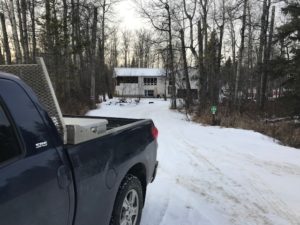
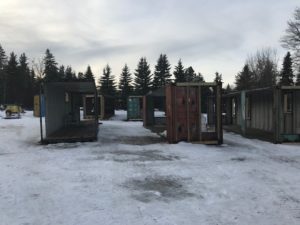
Maneuvering through the site
The foundation was blocked by the beams we were to set the cans on and a large welder and his gear in another trailer. We had to get that out of the way. Just to get in there, we had to use the smallest or shortest wheelbase we possibly could to make the corner out of the alley, then get as tight up to the foundation as possible, and squeeze over to the one side near the fence.
This would allow the trailer with the can on it to make that same turn out of the alley, slide by our truck crane, get under the wires, and hopefully get in far enough that our crane could lift the can and spot it into place. But the smaller crane footprint also meant it was not a huge crane; we had a good one, not a 50, or a 45 ton, but a 40 ton, with good reach.
If we could get back almost to the concrete foundation, it should work. We double-checked the charts and remeasured. The bottom tier was good. As we built the second story, the can on the far side was questionable. But if we had to, we could move the crane a few feet to make sure we were okay.
So, we set up our end and waited while Copperblock got the rest of their cans delivered for the job of infill in Edmonton Alberta. It was painful getting in there one more time, but we recognize the struggles of start-up and, at that time, sympathized. We remembered our own struggles and how much we appreciated any help we received, which makes this tale all the more surprising.
On the first day of the build, we maneuvered our crane into place and lifted the first two beams onto the foundation. The others were 40 ft long. The only place for them was against the fence, where our crane was. Pulling our crane over a bit to let them sit while we struggled with the backfilled, rutted, excess of dirt from the initial basement dig. We were sinking our legs without even lifting and we added more pads and found some solid footing.
We were so worried about our trailer not being able to access the site completely, that we brought another boom truck, a smaller one, with a special dead stick. If the trailer couldn’t get all the way in, then our big straight boom could lift the back, the smaller unit the front, and the tractor could pull away. At least that was the plan. The backup. We never put it on the bill; it was just back up. I just hoped the trailer made it all the way in.
Now the difficulty is setting in
We brought the shortest tractor we had, but the back-alley entrance was too tight with too many trees and cars. So, we drove into the alleyway across the street, got lined up and backed into our alley. As we approached our turn, we moved the little trailer, and got the angle we wanted, and started the turn.
The trailers can snap around corners; it’s the tractor that swings wide and hits things. That parked car wasn’t looking good. We pulled ahead into the T of the alley and cut our angle. It wasn’t enough. We got most of the way but got too close to the far neighbour’s fence. We tried again and gained a little — time for plan B.
The can was still 5 or 6 ft on the wrong side of the wires. The trouble was, there was a very unfriendly power pole, right on the property line where it joined the alley. Even if we lifted it, we could never swing it into the property, but we ‘could’ lift it. Next we would have to make this move in two parts. We jockeyed our little rescue truck until we had a reasonable line of sight at the end of the can and we did not want to lift from the top and intrude on the limits of approach for the power lines.
We had contacted EPCOR, and they had checked the power and given us clearances. The lower lines were a problem, but the real troublemakers, the three-phase lines, were high, and we were not to intrude on those. So, we stayed low so we could infill in Edmonton Alberta.
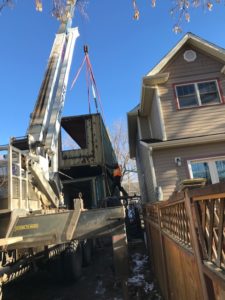
Lift Time
We lifted the can and our tractor and pulled slowly out of the site. As the trailer slide out from under our load, we lowered the can to keep away from any trouble and swung into the site until our rescue crane nearly contacted the wooden pole. We moved our picker at this point. We wanted to get the c-can as deep into the site as possible to make the crane’s work easier. It never got all that far in. These infill sites are narrow, the houses long, and the sites crowded. It was what it was, and we lifted the can into place.
Another full trailer was waiting, and we set that one too. The cans must be welded, secured and set perfectly, and we worked until dark. It was a mild day, but that night it rained, then froze solid — ice rain. Well, at least we weren’t on the highway. My crew started calling first thing. The crane had real difficulty getting back into the site. It couldn’t turn on the ice, and the tractor couldn’t get in the alley. This was trouble, but we had a gravel sprayer that we ran around our own yard to keep the place safe and workable.
We took it down to the site and made a couple passes down the alley, the entrances, and the whole back or the site. Then we gave an extra shot to all the local neighbours’ driveways and the front street; we just thought, what the heck, we’re here, might as well be neighbourly on an infill in Edmonton Alberta.
That worked, and my trucker managed to hit the angle perfectly and slide the entire trailer and can into the site. Perfect. And we went back to work. There were TV crews on site. It was a big deal, kind of a good thing we made it into the site. But it threw off our timetable. By the end of the day, we were nearly done. There were two to go, but it was dark and getting darker. The final placements were tricky, and we couldn’t see.
Copperblock wanted us to finish, but those wires were still up there, somewhere. We called it, and there was a bit of frustrated pushback that we didn’t understand. It was their crew in the danger zone, not ours.
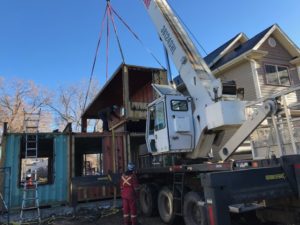
Finishing Up
So, we went back the next morning and finished. We took the extra boom truck, just in case. (Got a parking ticket for a large unit on a residential street though. We fought that but still had to pay it).
That was over a year ago, and we have not been paid a single dime. A couple of months ago, I went over to their shop in frustration and took my rigging back. It was specially designed equipment that we had developed ourselves.
It still amazes me that a company that we worked so hard to help out acted in this manner. We still know how to infill in Edmonton Alberta.
Don Lucas, Encore Trucking
